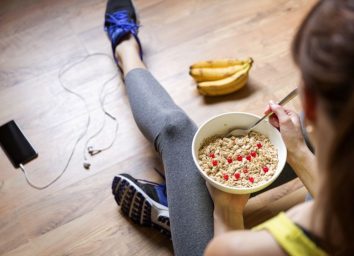The #1 Eating Habit for a Lean Body, Says New Study

Most diet culture fads perpetuate the idea that you need to restrict your eating in order to lean out your body. However, a recent study analysis published in Obesity proves otherwise—that what you add to your plate actually matters versus what you are taking away.
In this review, Rutgers University researchers analyzed data from multiple weight-loss trials conducted within the university and found that increasing the amount of protein on your plate will result in better food choices and avoiding the loss of lean body mass.
The trial analysis looked at 200 men and women between the ages of 24 and 75 with a registered body mass index that categorized them as overweight or obese. Each participant was encouraged to follow a 500-calorie-deficit diet in order to lose weight, but with proper nutrition counseling and support for six months.
The analysis concluded that when 20% of the food intake comes from protein, most dieters also have a higher intake of green vegetables and a reduced intake of refined grains and added sugars. While these foods aren’t completely eliminated from their diet, the higher amount of protein in their meals results in a desire to complement the meal with other healthier items and a reduced desire to eat unhealthier foods.
The researchers also point out that typically when dieters lose weight, they are also losing lean body mass along with it. It states that anyone who undergoes a weight loss regimen encouraging calorie restriction will likely also reduce the intake of healthy foods with essential micronutrients. If you’re truly looking for a leaner body versus just a skinnier one, the analysis recommends consuming a higher amount of protein and improving the quality of your diet to keep that lean body mass.
For example, the study points out that although both the low- and high-protein groups lost the same amount of weight (around 5% over the six-month period), the higher-protein group ended up eating healthier foods overall and retained a higher amount of lean muscle mass.
How to calculate your proper amount of protein

The Dietary Reference Intake (DRI) states that the recommended daily allowance (RDA) for protein is 0.8 grams per kilogram—which is equivalent to 2.2 pounds. So if you are 160 pounds, your RDA for protein would be around 72.5 grams of protein.
However, the amount of protein recommended in the DRI may not hit the 20% you’re looking for. In order to determine how many of your calories are coming from protein, multiply your grams of protein by four, then divide that number by the total calories you consumed in a day (one gram of protein calculates to four calories). So if you ate 1,800 calories in a day, 72.5 grams would be a little over 16%.
To find your protein needs, calculate what 20% of your total calories is for the day, then divide that by four. For example, 20% of 1,800 calories would be 360, so divided by four that would be 90 grams.
Look for lean protein sources
Participants of the studies analyzed were encouraged to consume lean sources of protein such as poultry, unprocessed red meat, fish, legumes, and dairy. Alongside these protein sources, they were encouraged to balance out their diet with fruits, vegetables, and whole grains, while reducing their intake of saturated fats, refined grains, sugar, and salt.
Focus on better protein options with this list of Best Forms of Lean Protein You Can Eat.









